Bristol Light Festival is back! The fifth iteration of the annual event began on Friday 31st January and will run until Sunday 9th February, with 10 installations brightening up the city at a traditionally dark time of the year.
Bristol Light Festival’s digital programme is now available to view here.
The festival covers much of the city centre, with artworks located in the Harbourside, Broadmead, College Green, St Mary Redcliffe Gardens and beyond…
College Green has become home to a flock of bright and beautiful flamingos, delighting visitors with a whimsical display of nature’s most flamboyant creatures.
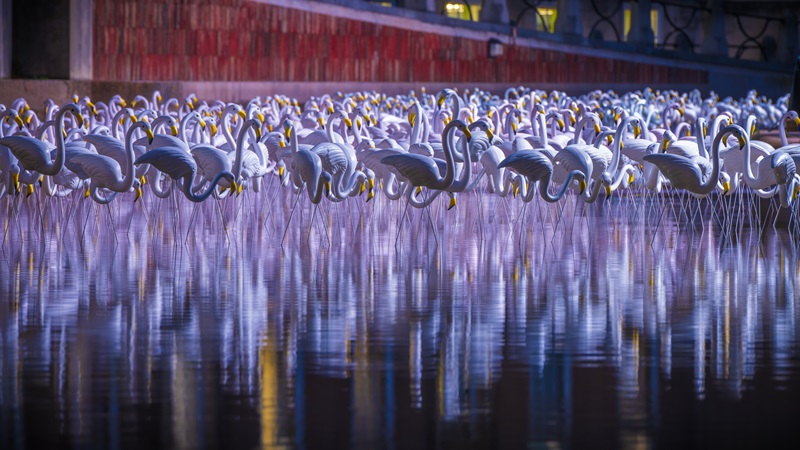
Shrouding the Amphitheatre in a cosmic blend of light and sound, Somnius responds to the audience’s every move, immersing crowds in a playful environment that puts them in control of their experience.
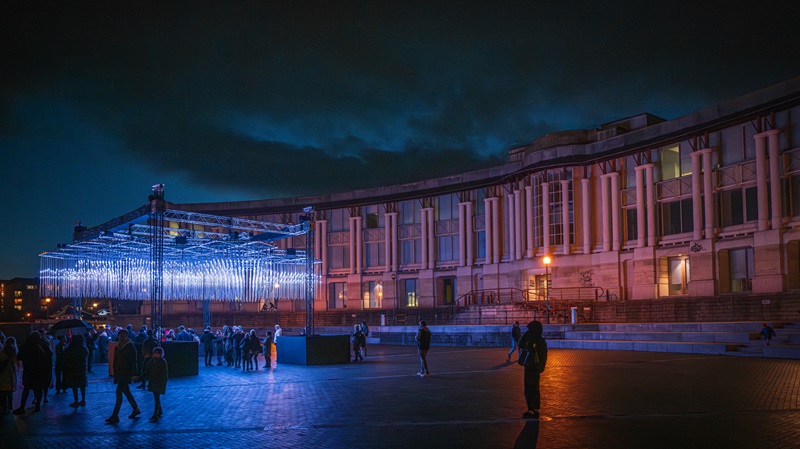
Those crossing Castle Bridge are being painted in reflections of shimmering light as they admire the suspended facade of more than 1,800 recycled CDs and DVDs, inspired by the waters of Sydney Harbour.
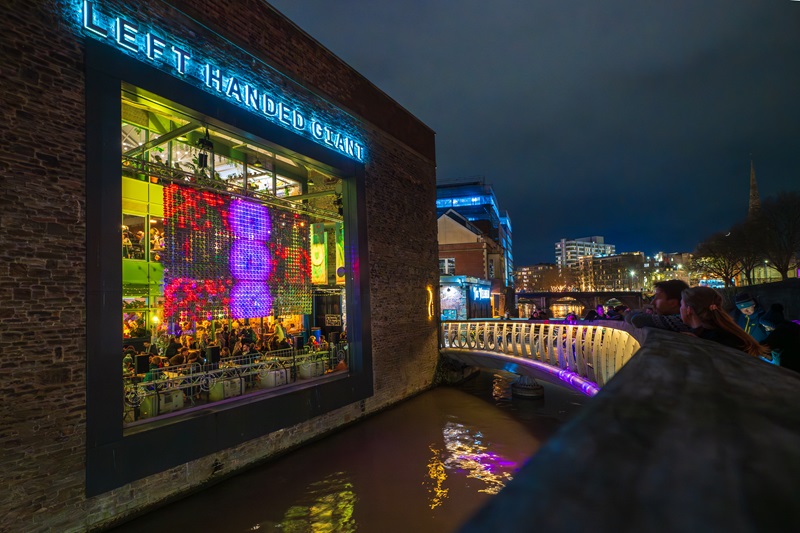
Back for another year of musical delights, Swing Song can be found on Queen Square. Due to popular demand, Bristol Light Festival organisers have introduced a fast track ticket for one set of swings at this year’s event. More information around this, including how to book, is available to view at bristollightfestival.com/swingsong

Lighting up the gardens of St Stephens Church is Our Beating Heart, an enormous heart-shaped disco ball that brings people together in its display of shared love.
At Broadmead, visitors to the festival can find Tetra, a tactile installation that needs to be engaged with to truly be felt and understood, taking inspiration from the many forces of nature.

Temple Church has been illuminated into a world of lasers and mirrors, where moving footage of natural phenomena like flora and the cosmos are being transformed into floating abstractions of light with Parallels.

The world premiere of The Whilers can be found in St Mary Redcliffe Gardens, where otherworldly creatures greet visitors as they interact with each other in an awe-inspiring experience.
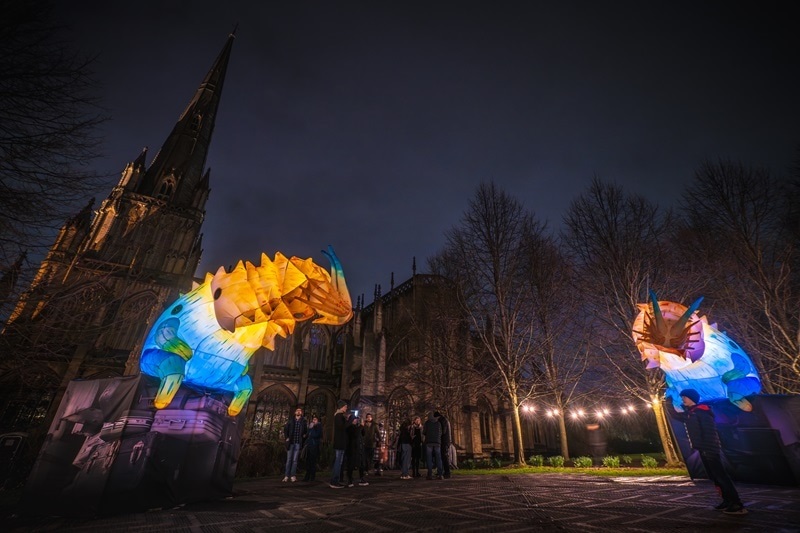
Bringing the history of drum and bass to the centre of Bristol, Anthems: Volume One is inspired by the historic connection between the city and DnB music and can be found at Quakers Friars.

Katherine Jewkes, Creative Director of Bristol Light Festival, said:
“Bristol Light Festival 2025 is underway and it’s amazing to see such a positive response from visitors once again.This year brings such a variety of artworks, but at their core is a real sense of togetherness and connection with audiences. We look forward to seeing what the run holds for visitors and hope that even more people will come to Bristol to see all that is on offer!”
For the current edition of Bristol Light Festival, several Fringe events are happening across the city to allow visitors to amplify their experience.
Photography Walk – Monday 3rd February and Wednesday 5th February, 5:30 – 7pm
Award-winning photographer Adrian Wyatt will be guiding budding photographers around the installations, offering guidance on how to capture the best shots of the installations.
Walking Tours – Monday 3rd, Tuesday 4th, Wednesday 5th and Thursday 6th February, 5:30 – 7pm
An opportunity for festival-goers to orientate themselves within the locations and to learn about the installations. Participants can choose between the ‘waterfront’ or ‘central’ routes, or join an accessible tour.
Official Silent Disco Tour – Wednesday 5th February, 5:30 – 6:30pm, Starting at Bristol Cathedral
On this one hour tour, visitors are invited to boogie their way between art installations accompanied by hit tunes from across the decades. High tech headphones mean that users will be able to hear both the music and their tour guide as they make their way around some of the festival’s highlights.
Neon Kids Rave – Thursday 6th February, 4 – 7pm, Bambalan
The whole family is invited to brighten up February with a non-stop rave party including bright colours and plenty of opportunities to boogie. Tickets can be purchased here
Lights Under the Sea – Saturday 8th February, 10am – 7pm, Bristol Aquarium
To celebrate Bristol Light Festival, the Aquarium will be open later on this date, so visitors can experience the aquarium after dark with its botanical house magically lit with colourful lights. Special UV animal crafts will be available throughout the day, free of charge with an aquarium ticket.
For more information about all events, and to book, visit bristollightfestival.com/events
For the 2025 event, Left Handed Giant has once again created the event’s official beer. This year’s ‘Shining Stars’ is a bright and balanced pale ale, full of citrusy grapefruit and juicy tropical character, from a blend of citra, motueka and el dorado. While visitors check out C-Scales at Castle Bridge, they can grab a can of Shining Stars from Left Handed Giant Brewpub to enjoy the full Bristol Light Festival experience. Shining Stars will also be available at Small Bar, Glassboat and the Royal Navy Volunteer.
Bristol Light Festival’s hub can be found at Queen Square. The perfect place for visitors to meet, regroup and rest, the hub hosts merchandise, including branded beanies, tote bags, light up umbrellas and prints. The hub also houses the information hut, seating and a food market, as well as being the site of two of the festival’s installations – Swing Song and Bristol is Always a Good Idea.
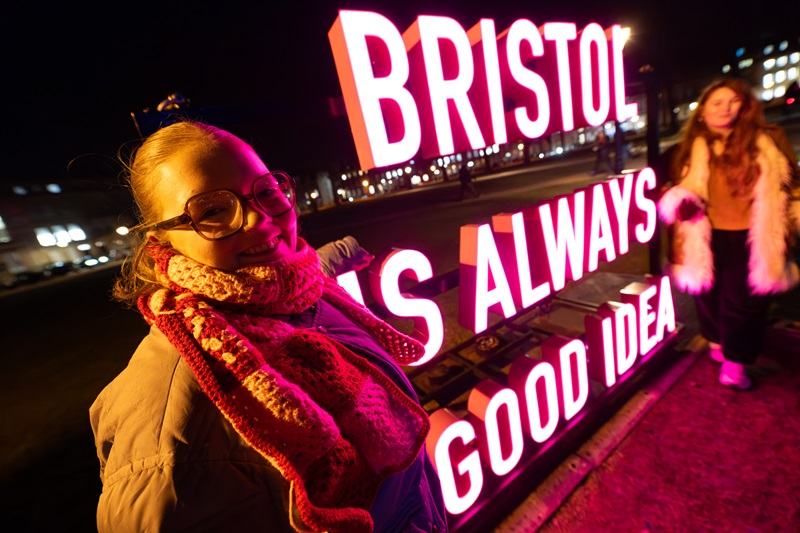
Bristol Light Festival was founded by Bristol City Centre Business Improvement District (BID) and is presented in partnership with Redcliffe & Temple BID. The festival’s Artwork Partners are Broadmead BID and Cabot Circus. Visit Bristol, Visit West’s consumer channel for Bristol, is this year’s media partner. The festival is curated by Katherine Jewkes, Creative Director.
For those looking for somewhere to stay in Bristol City Centre during the festival, a list of offers and discounts for some of the best hotels in the area can be found at bristollightfestival.com/accommodation. The festival recommends booking early to avoid disappointment.
Bristol Light Festival recommends travelling as sustainably as possible. Visitors are encouraged to walk or cycle to the festival where possible, or to utilise the many train and bus options available to the city centre. More information about getting to the festival can be found here: bristollightfestival.com/getting-here/
All information about the festival can be found at bristollightfestival.com
Images credit: Andre Pattenden
Fiasco is excited to announce that Gabby Luciani has joined the team as Account Director. Gabby brings over 10 years of experience working as a creative producer and account handler at some of the finest small and mid-sized agencies across London and the South West. With past clients that include YouTube, Activision, Nike and WWF, Gabby’s breadth of commercial experience, combined with her passion for creative collaboration, makes her a fantastic addition to their growing team.
“Gabby’s varied experiences have given her the perfect mix of commercial experience and know-how. I have no doubt she’ll play a key role in driving the agency forward as we approach our 15th year in the business.” – Ben Steers, Co-founder and Executive Creative Director.
Gabby adds: “Joining Fiasco feels like the perfect opportunity to contribute to a team that’s not only brimming with creativity and ambition, but also deeply committed to delivering meaningful, impactful work for their clients. I’m thrilled to be part of an agency that’s constantly pushing boundaries and focused on thoughtful growth. ” – Gabriella Luciani, Account Director.
Fiasco is a design agency that works at the sweet spot of brand and digital. People are at the heart of everything they do. At Fiasco, each and every team member brings a unique perspective and every voice is heard. You can read more about Fiasco and Gabby, over on their site here.
Nine Tree Studios, Bristol’s biggest independent studio, has launched a WhatsApp Community to give back to local filmmakers, photographers, creatives, and production companies.
Primarily it’s a free loyalty programme offering studio discounts and freebies, including:
There’s also groups for advice and jobs, and private channels for production companies and studios to collaborate and share advice.
“We’ve always wanted our space to be able to support Bristol’s creative community” said Russell Jones, Co-Founder of Nine Tree Studios.
“Nowadays email newsletters feel old and clunky and aren’t really suited to what we wanted, like offering free studio hire to those who need it, and promoting and discussing events.”
“By virtue of having members we also hope it’ll be a space for freelancers, screen professionals, studios and production companies to share advice, post jobs, collaborate, and generally chit-chat.”
You can join the community at https://chat.whatsapp.com/D64qZ5CmnxCASYEevxDFEV and visit https://www.ninetreestudios.co.uk/community for more information and terms.
***
Nine Tree Studios is Bristol’s largest independent studio.
Suitable for set builds, commercial productions, photography and HETV, the space features two main studios – a 4,640sq ft soundstage and a 567sq ft infinity cove – plus a podcast suite, green rooms, production offices and a 9,000sq ft backlot.
For more information visit www.ninetreestudios.co.uk or email [email protected].
In my last blog I talked about the three superpowers you need to create a great company culture, those of Connection, Purpose and Trust. But there’s a little more to it than this. These superpowers are supported by what I call the elements or ingredients that make the great culture you want to become a reality.
Now, I’m sure you’ve come across companies that have put in a pool table, have lots of Zoom quizzes, and they think that will suffice. Maybe they’ve even put in sleep pods in their attempt to have the funkiest office in town. Of course, all of this doesn’t make a great culture if the organisation doesn’t deliver on Connection, Purpose and Trust. And that’s where my tips come in.
1) Have a culture strategy
As you can tell, I’m a little cynical about gimmicks. You need to think a little deeper. A little more strategically. Where are you now in terms of your culture, where do you want to be? What’s your ‘target culture’? And how can you measure this to create your start point. For me, the people that drive a culture strategy are, or should be, the leadership team.
As we know, leaders are your role models. They have a profound effect upon company culture because they shape the environment, they influence how people behave, how people interact, and they drive motivation and performance. And of course, what the leaders do is look at the strategy and look at the purpose. Your leaders need to be involved in your culture strategy but more than this, they need to display the right qualities.
2) Authentic leadership
The great leaders I’ve worked for, display qualities like empathy, resilience, integrity, and they’re authentic. And that really does set a strong foundation. Going right back to childhood, we tend to model the characteristics we see in others, especially those who we feel we should look up to. Whether it’s parents – or leaders – the behaviours we see we often replicate.
So, my second tip is about making sure your leaders display the right qualities and develop them. And it’s often the leadership team that can make a big impact in often small ways. Little interventions can make a big impression on development.
3) Help them find their purpose
I’ve done many culture audits where I ask people for their views on the culture, why they work for that organisation and what motivates and engages them. And I always ask a really key question. Can they articulate the purpose of the organisation? Is it important to them? Can they join the dots on how their role aligns to that actual purpose?
And I would say in having done this with over 30 organisations, about 50% of people cannot articulate the purpose. It may be because there isn’t one or maybe because it’s not clear. My question to you is – can you give your people a reason ‘why’ and reinforce it?
4) Upskill your leaders and managers
It’s quiz time now. What percentage of people in a recent survey said they would prefer a new manager to a pay rise? Shockingly it’s a whopping 72%. I love this question because it was asked by the Chartered Institute of Management, and it clearly demonstrates how important the relationship is between the employee, and the manager or leader. I think managers have such an influence on people’s day-to-day work style and behaviours.
They are there to support and coach people, not micromanage. But, from my experience, many people are not skilled at being great people managers, they are often promoted to be people managers because they’re technically good at what they do. So, tip number four is to upskill your leaders, upskill your managers to be brilliant coaches, and that will have a dramatic effect on the culture.
5) Give your people choices
I hear this a lot, certainly since the pandemic. We gave people flexibility and they’d rather like to keep it. Of course it means different things to different people. It might be about working hours; it might be about working locations or actually how they do their work. I believe it’s something deeper than actually flexibility. I think people want autonomy in their roles, they want control over how they do their roles.
So, tip number five is really all about giving people a choice. And not the least because they also have the choice of whether they work for you or engage with a culture they perceive to be better, elsewhere.
In conclusion
If there’s one word underpinning these five tips, it’s ‘involvement’. Whether that’s your involvement in crafting a culture strategy, involving your leaders or asking your people for their own thoughts – and involving them in making all of this happen. If I’ve whetted your appetite for investing in creating a great culture, you’ll be pleased to know that my next article shares 5 more tips. Or maybe that’s 6. You’ll have to wait and see.
About Richard Roberts
Richard Roberts has over 30 years’ experience of helping organisations establish dynamic people strategies that help to shape culture and build highly productive and engaged teams. Across his career he has supported a number of marketing and creative agencies as an outsourced HR Director and consultant.
People Strategy Surgery – for creative businesses
Members can book a free of charge 30 minute 1:2:1 session with Richard for people strategy advice, specifically geared towards the needs of creative businesses. Taking place on 10th January 2025, these sessions are an opportunity to ask him any questions about your people strategy. These might relate to culture, employee engagement, talent retention or the establishment of best practice HR policies.
Find out more: https://bristolcreativeindustries.com/event/people-strategy-surgery-with-richard-roberts/
I’m often asked what’s the magic formula for creating a successful and engaging culture? What’s the fairy dust that needs to be sprinkled? Well, the bad news is that it takes a lot of hard work, it takes a lot of effort and thought. But here’s the good news. You have the power to create a culture that’s truly aspirational and great.
Every organisation has a culture and if you don’t focus on it, your culture will be created by accident. Worse, it might be a culture that’s created that has a real negative impact on your business. So, what does it take to get it right?
From my experience there are three key elements that every organisation should focus on in order to have a really engaging culture.
Connection. Purpose. Trust. These are what I call your three culture ‘superpowers’. Create these and you’ll become your very own culture superhero. Let’s take a closer look.
Building Connection
It’s all about being a part of a team. It’s about the camaraderie. In my last full-time role, I worked for a company called Pure Planet, we were a provider of sustainable domestic energy with a strong environmentally friendly ethos. Many felt a real emotional connection, and of course, we’re all social beings and this connection also led to a sense of belonging. And, we all want to feel like we belong. Indeed, there’s quite a lot of scientific research that shows that being connected is a fundamental need that human beings have, and I think this is crucial to having a really engaging culture.
Finding Purpose
Building on connection is wanting to be part of something bigger. And this for me is all about purpose and our need to find a purpose in what we are doing in our life and work. Many of you will know of Simon Sinek. He says very clearly through his research that a lot of companies can tell you WHAT they do. They can tell you HOW they do it, but very few can tell you the WHY they do it. And it’s actually the why that motivates and engages people to put in extra effort.
Feeling Trust
Trust is the third element and kind of underpins it all. It’s a very small word, but I think it’s absolutely fundamental. When I look back on my career to when I felt I most engaged, most motivated, and where I felt there were the best leaders – it was where I could be myself, I felt trusted, I felt safe. And I think this is absolutely key. In the HR world, we call it psychological safety. It’s that ability to be yourself and to behave in the way that you want to behave.
What’s more, the benefits of a high trust culture have been researched. Psychologist and professor Paul Zak found that the levels of trust experienced directly influences how willing your employees are to go above and beyond in their roles. This data comes from his book, ‘’Trust Factor: The Science of Creating High Performance Companies’. People working in companies in the top quartile of trust are: 76% more engaged, 50% more productive and 50% more likely to stay. I rest my case.
In conclusion
So, in summary, these are the three key ingredients of a great culture: Building a sense of connection, finding purpose and feeling trusted. And, just to emphasize again why getting it right really matters, Gallup found that over half of employees (56%) said company culture is more important than salary when it comes to job satisfaction. So, it’s worth making yours a positive one – and now you know the superpowers you’ll need.
About Richard Roberts
Richard Roberts has over 30 years’ experience of helping organisations establish dynamic people strategies that help to shape culture and build highly productive and engaged teams. Across his career he has supported a number of marketing and creative agencies as an outsourced HR Director and consultant.
People Strategy Surgery – for creative businesses
Members can book a free of charge 30 minute 1:2:1 session with Richard for people strategy advice, specifically geared towards the needs of creative businesses. Taking place on 10th January 2025, these sessions are an opportunity to ask him any questions about your people strategy. These might relate to culture, employee engagement, talent retention or the establishment of best practice HR policies.
Find out more: https://bristolcreativeindustries.com/event/people-strategy-surgery-with-richard-roberts/
Some of the best moments in my talks on company culture and employee engagement are often the questions I get asked. They really open up the conversation and reveal the issues as people in the room see them. As these are often people managing teams, perhaps even the business owner – you get a sense of what’s on their mind.
These questions have inspired a new blog series. I’m going to tackle topics relating to company culture on a Q&A basis, using some of the questions I’ve been asked and adding a few of my own.
A positive and engaging company culture is about connection, purpose and trust. That’s connection with your organisation, the purpose they find in their work and the levels of trust they experience.
So, let’s start at the beginning – and explore why connection matters so much.
What role does connection have in creating an engaging culture?
People are seeking an emotional connection with where they work – or who they work for. They want to be a part of something that has meaning. They want to be a part of something that has that sense of connection or be a part of something bigger. When people feel connected, they also almost always feel proud to work where they do – and that’s highly powerful. I think one of the key challenges now is how you nurture connection in a more virtual hybrid way. So, I think it is absolutely essential that employers invest time and energy and thinking into how they keep their people connected.
Why are so many employers talking about connection and culture right now?
I think employers are realising that it’s a key factor in having a profitable and successful business. There’s far more research out there now on what makes a great culture – and it matters too. For example, Gallup found that over half of employees (56%) said company culture is more important than salary when it comes to job satisfaction.
I think the significance of culture has increased because people have realised what makes a great business and what doesn’t. Just look at the number of companies that are now offering engagement culture surveys, engagement platforms, and the importance of technology in keeping people connected. It also cascades into what employees think of leadership style, and how they are being managed. I’m quite sure employers realise that their culture is being judged which is why they are keen to discover what their people think.
Why do you think it is that companies are struggling to build connection?
I think they haven’t really adapted to managing people in a hybrid world. The problems start when companies try to manage people as if they were still in the office on a daily basis, or if they have a very direct ‘command and control’ style of management. They haven’t adapted to the fact that this is a different way of working now. It needs some thought when your business is in Cardiff and the person you’ve just recruited is based in Scotland. It’s about the actions you take, that send clear messages to your new employee that ‘you’re part of us, you’re part of our community, you belong with us’. Or completely the reverse if they neglect it.
Can you give some examples of what companies can do to build better connection?
If you think about connection in an organisation, where’s that going to come from? It’s going to come from your team. So, create opportunities for people to connect. If you can, meet once a month, for example face-to-face. I know that can be difficult in certain circumstances. Always have an element of getting to know you. For example, that could be showing pictures of your kids, bringing in a special object that means something to you and describing it. I’m a great believer that it’s actually the small things that have the biggest impact. Maybe that’s just arranging a random coffee with somebody from a completely different team every week, or simply checking in to see how remote based colleagues are doing. And don’t forget that with global organisations, people are working in different time zones. You might have a great idea to run a team building quiz – but no one is going to join in at 3 am in LA. So, think time zones when you are planning these things.
What advice would you give a line manager to build better connection?
Often the reason people leave is that things have gone sour with their line manager. I think companies just assume that line managers know how to manage and do it in their particular culture. Help them to understand the expectations that you want from your managers. And that might be as basic as we would love you to do a regular one-to-one with your team member each week. If so, give some guidelines about how to run a one-to-one and build connection. Then you need to train, support, guide and coach that person. I’d also say please don’t move those one-to-ones. I know they are the easiest meetings to move but they really matter, especially with remote based employees. A great tip for line managers is when they introduce a new starter, don’t just say who they are and the role they are going to do – find out three things about them that others might find interesting. It’s just a small example of the little things that help us all connect to each other. We can be a bit more creative than just sending out a really dull email.
Despite expectations about hybrid working, companies are wanting more people to return to offices. How can employers manage that better?
It’s another difficult challenge. I am not keen to see employers mandating a return to office policy, these can be deeply unpopular. I also think we’ve seen many examples of highly effective remote working so people have fair case to push back if they feel they can work from home. But, the office, and face to face contact is a great way to find, or re-discover connection, so, if you are going to request it, at least make it meaningful. Give them reasons why they’d want to. And this doesn’t mean going in to do the same work they could do from home, that’s really going to annoy people. What’s more, I think companies underestimate the social part, the water cooler chat or being in the coffee room and having a, “Did you see the football last night? It’s a shame Wales got beaten in the World Cup,” and all that kind of stuff. We need to connect with each other as much as our organisations.
Any tips for leaders to build connection back in the office?
I think people are more creative when they get together and that could be working on a shared problem. Definitely projects run more smoothly if people are getting together on a regular basis. It’s also about understanding people’s different styles. One thing that’s worked really well on leadership development is where you have managers who meet regularly once a month just to talk about managing people and sharing their stories, the good, the bad, the things that they’ve tried. It can be really great advice to share, just as a peer group and it’s far more likely to happen face to face.
If you would like to find out more, on Friday the 15th of November at 8.30am, Rich will be running a Wake Up Call session on the “10 top tips for creating a successful and engaging working culture”
About Rich Roberts:
Rich Roberts is an employee engagement and culture specialist and is passionate about building highly motivated and productive teams in both start-ups and larger organisations.
Why are some organisations more able to recruit and retain their people than others? And why do some people perform better, with stronger employee engagement and a willingness to go the extra mile? It’s often down to the culture of an organisation.
Culture is becoming increasingly important to employees. If you need any convincing, consider this. A Glassdoor survey found 77% of respondents would consider a company’s culture when searching for a new job.
Is there a culture formula?
Culture is something that’s hard to pinpoint, as there’s no magic wand or secret formula. But, as someone who has spent more than 30 years developing positive and motivating cultures within organisations, I can sum up why it matters in one short sentence.
It’s how your people feel about working for you.
The good news is that you can influence how your people feel – whether you are a line manager, in an HR or people role, or perhaps the CEO yourself. In my experience, these are some of the most important contributors to building a positive culture.
Connection
Organisations are all about people working together, regardless of location. They are about human relationships – something that was tested throughout the pandemic. And that’s why now, even if hybrid working remains important for many, so does the opportunity to meet, work together and enjoy the buzz and productivity that comes from spontaneous interactions. That only comes through real connection. When employees feel more connected to their colleagues and their company, their overall perception of their company improves, as does their feeling of wellness.
Post pandemic many of us are in different locations and may remain this way. That’s why coming together in a physical place, on a regular basis can help. It doesn’t have to be purely for work either. Team socials are a powerful way to re-connect. Line manager soft skills are important too. The more approachable and empathetic they are, the better the sense of connection to the business and the relationship. And don’t forget the onboarding of new employees, especially if they are going to be working remotely.
Purpose
The purpose of an organisation is increasingly important and one of the main drivers as people re-evaluate their careers. Increasingly, they want to work for an organisation that makes a difference and feel that their role contributes to this. When this happens, people who live their purpose at work are more productive and engaged, more resilient, and more likely to stay.
The key to a purpose driven culture, according to author and speaker Simon Sinek, is to know why you do what you do. He says a lot of companies can tell you what they do, they can tell you how they do it – but very few can tell you why. And it’s the ‘why’ part of that purpose that employees increasingly want to be sure about. Purpose has to be authentic too. This means saying what you do – why you do it – and then actually doing what you say. If not, your people will see right through what they may consider hollow gestures – and that’s not going to feel good.
If your purpose hasn’t changed, re-focus on that – it’s what may well have attracted people to you in the first place. If the pandemic has caused your business to pivot in strategy, share where you are heading and emphasise how their roles can still align to that new purpose. Needless to say, leaders have a big part to play in communicating purpose.
Trust
Trust was often the ‘glue’ that held organisations together during the pandemic. It was challenging for many line managers too, but those who showed their people they trusted them to deliver often got the best back in terms of productivity. There’s no reason why the same levels of trust can’t be shown now. Indeed, rowing back on trust and autonomy is likely to be damaging to the goodwill that exists.
Research by US neuroeconomist Paul Zak confirms the importance of trust in terms of building a positive and engaged culture. He found that compared with people at low-trust companies, people at high-trust companies reported: 74% less stress, 106% more energy at work, 50% higher productivity, 13% fewer sick days, 76% more engagement, 29% more satisfaction with their lives and 40% less burnout.
Leaders and line managers can influence culture by building trust in what they say (and deliver) as well as how they act. This also applies to how they respond to failure. Employees will take risks and make mistakes and must feel trusted despite this, otherwise how can they learn and develop?
Communication
Communication is often something an organisation thinks it has got right – when the reality is the very opposite. Holding events in physical buildings and forgetting those working remotely. Communications that don’t include everyone. Asking for feedback – but forgetting to send the email to those working from home. The list could go on.
Everyone wants to feel that they have a voice and their opinions matter. I find that leaders who take the time to encourage two-way communication not only increase engagement and belonging, but hear some pretty good ideas in the process. Simply asking “how can we make this better for you” shows you care and also encourages constructive feedback. It says to your employees – ‘you have a voice here and you matter.’
Development
The more developed your employees feel, the more positive they’ll feel about your culture. When employees grow personally and professionally, being more passionate and engaged about what they do tends to develop too. The more they learn, and see themselves developing, the more motivated they are to keep going. This creates more capable and more loyal people who reward the organisation by staying.
An organisation that supports learning and development isn’t just producing more capable employees or leaders. They are producing more capable people in life, more balanced and almost certainly with a better sense of wellbeing. It is worth doing a skills audit – looking at the capabilities you need, the people you have and aligning their development needs with that of the organisation.
In conclusion
I started by talking about connection, that’s a very human need. All the points made here are really different aspects of what might be called a human or people first culture. People need to feel wanted, valued, trusted, developed – all of which apply both inside and outside of work. These are also my personal ‘take’ on the cultural issues that affect how your employees feel about working for you. Always have in mind that their view is a fluid state. You can nurture and engage them through your culture, but you can also do the opposite.
Author: Rich Roberts employee engagement and culture specialist, enRich.
If you would like to find out more, on Friday the 15th of November at 8.30am, I will be running a Wake-Up Call session on the “10 top tips for creating a successful and engaging working culture”.
Being an Employer of Choice: Mental health and financial wellbeing are inextricably linked!
Sometimes, all it takes to drastically improve your employees’ quality of life is a conversation and guidance that can lead to a positive impact that they feel every day. Nobody is immune to money worries and financial stress. So, let’s get talking, break down taboos and change lives.
Poor mental health and financial problems are often closely tied. Fixing one can often help fix the other. Talking about money worries is a bit of a taboo subject in the UK. The topic is surrounded by stigmas such as debt, poor mental health, and absence from work, so we avoid it. But sweeping things under the rug doesn’t work. Long-term, if we don’t break taboos, taboos can break us.
Financial education plays a huge part in increasing preparedness and reducing stress. But stress and worries can build barriers in people’s minds, a powerful resistance to engaging. They may have the answers but feel overwhelmed or unsure where to start. So, to forge a path forward, we need to be there with them.
To help people see through the haze of financial stress, we need to connect with people as individuals, on their own level.
A vicious cycle
Poor mental health can lead to money problems:
And money problems can lead to poor mental health: Stretched budgets could mean less food, heat, or medicine. Financial communications might trigger feelings of anxiety and panic and persistent worrying could lead to sleep problems and burnout
This cycle can get out of control, spiralling downward and affecting relationships, work, and every other part of an employee’s life. It’s critical we let them know that help is at hand.
Breaking the taboo
If you don’t offer much support yet, it’s a good opportunity to get employees involved. Ask them what they want and need and build around their answers.
Maybe some want private 1-2-1 meetings, while others would prefer group workshops or an anonymous online forum. By starting the conversations here, you’ll already be taking steps to normalising talking about money and financial stress and showing that it’s important to your business.
Why employers should care
Why dedicate resources and people to tackling financial stress? According to UK charity Mental Health At Work, 66% of employees feel like their company doesn’t care about their financial situation, making them more likely to salary hunt elsewhere and less productive in the working day.
In other words, beating financial stress is in your business’ best interests too. And if you have limited resources, you can partially rely on the government’s Money and Pensions Service.
Voice actor and founder of BRAVA (Bristol Academy of Voice Acting) Melissa Thom, has become a full voting member of BAFTA.
Melissa will now have a say in the winners of the Academy’s annual BAFTA Games Awards, which are presented annually to recognise, honour and reward outstanding creative achievement in games. The Awards are voted by an expert membership of over 1200 experienced professionals and are watched by millions online.
Melissa and BRAVA’s team of master coaches have trained hundreds of people in Bristol and beyond to become professional voice actors, with many already working in the gaming industry.
BRAVA has connections with games production companies and bodies across the UK and internationally. Melissa and her team work to support those coming up in the profession, liaising with industry stalwarts and championing diversity. Melissa’s gaming work as a voice actor includes roles in ZeniMax’s The Elder Scrolls (Necrom and Gold Road) and Grand Theft Auto V.
Melissa is British, with Indian-African heritage, and feels strongly about the need for diversity in the gaming sector. Melissa said:
“The online games industry is estimated to be worth almost $28 billion worldwide, dwarfing the film and music industries. It’s thriving and has a powerful influence. As the popularity of gaming continues on its upwards march, it’s critical that people from all backgrounds see themselves represented in games.
I am thrilled to be recognised by the Academy for all the work we do behind the scenes to support and guide voice actors and improve working conditions and diversity within gaming. I’m also committed to supporting the gaming community in the South West, which is a hot bed of creative talent.”
Melissa invites any actors in the South West with significant gaming experience to get in touch with her if they need support or advice.
-ENDS-
About BRAVA
Founded by experienced voice actor and communications consultant, Melissa Thom, BRAVA brings together acting and voice experts from the UK & US to deliver best in class training and advice about the industry.
At BRAVA, all learning is done online, meaning students can learn at their own pace, wherever they are. Training is offered as personalised 1-1’s or group sessions and covers a wide range of topics, including Getting Started in VO, Corporate, Commercial and Narration, Characters, Audiobooks, Performance Techniques, Home Studio, Marketing, Vocal Health, VO & Shakespeare, Voice, Presence, Impact, Presentation Skills and more.
Find out more at www.brava.uk.com
Melissa Thom’s IMDB: www.imdb.com/name/nm10724768/
Looking for a new jacket? According to Ibis World, there are 298,036 apparel manufacturing businesses globally. So how do you choose where to buy?
There’ll be several elements that affect a purchasing decision – particularly cost, quality, and/or location. But other factors that play a major role in where consumers shop are values and authenticity.
In fact, 90% of consumers say that authenticity is important when deciding which brands they support. In addition, 75% say they are likely to buy a product from a company that shares their values.
So, why are values and authenticity in marketing so important?
We’re now in an age where fake news, deep fakes and influencers peddling products they don’t actually use is the norm. And with the rise of e-commerce, we’re constantly being sold items and services every hour, of every day.
This bombardment of false promises and shallow marketing has driven customers to look for companies with more substance; companies that support their claims with actions.
Customers typically see straight through – and don’t appreciate – inauthentic and impersonal marketing tactics.
So how can you ensure your business doesn’t make these mistakes? It all starts with ‘why’. Why do you do what you do in the first place?
Being authentic and having strong values go hand in hand. But there are some important distinctions between the two.
AUTHENTIC: According to Oxford Languages, the definition of authentic is ‘of undisputed origin and not a copy; genuine’.
VALUES: The definition of values is ‘principles or standards of behaviour; one’s judgement of what is important in life’
While values are about beliefs and one’s outlook on life, authenticity is about who you are as a person (or in this case, business).
Unfortunately, an all-too-common occurrence is businesses falsely claiming they have certain values and beliefs to gain social clout and more customers.
This is also known as colourwashing (which we’ve written a blog about here). Not only can colourwashing slow down progress towards positive and important changes, but it also creates distrust in your company.
Stretching the truth about your values, and not being transparent in your marketing activities, will weaken the connection you have with your customers.
Not convinced?
According to a 2016 study, almost 94% of all consumers are more likely to be loyal to a brand when it commits to full transparency.
And when you obtain loyalty from your audience and customers, you’ll see business growth, more people making repeat purchases, and an enhanced company reputation.
Almost 94% of consumers are more likely to be loyal to a brand when it commits to full transparency.
You may be wondering where to start when conveying your values truthfully to your audience.
First you need to establish what your values as a business are.
Next, start showing you mean what you say through action.
For example, you could raise awareness of issues and organisations that align with your values, or donate some of your business’ profits to relevant causes.
It’s also important to note that this action isn’t a one-and-done situation. You need to continuously back up your claims to build audience trust.
Now, it’s time to tell people about it!
Communicating your actions and values both internally to your team and partners, and externally to your customers and stakeholders, is vital for a business. It deepens connection and understanding between your company and your audience.
Communication examples include:
What to do: Mind Corporate Partnerships
Mind is a mental health charity that stands up to injustices in healthcare, work and law which make life harder for people with mental health problems.
A section of their charity is dedicated to corporate partnerships so businesses can work with Mind to support their work and help fight for mental health.
This feature is so effective because not only are they starting a conversation with individuals, but they’re opening connections with businesses so even more people can get involved.
Their website contains plenty of resources and support for those struggling with their mental health, including workplace wellbeing.
By pairing their business statements with tangible resources, more people are likely to work with them and recommend their services.
What not to do: Naked’s lack of transparency
For this example, we’ll look through a more B2C lens, although the principles still apply to B2B businesses.
Naked offers a range of juice drinks, manufactured by PepsiCo. These products are marketed in such a way as to lead consumers to believe they’re a healthy option.
Statements on its packaging once included ‘only the best ingredients’ and ‘no sugar added’, but the Centre for Science in the Public Interest filed a lawsuit in 2016 because they were misleading.
In fact:
Following the lawsuit, Naked amended the erroneous claims and offered compensation to those who purchased products between a certain timeframe.
But despite its attempts to rectify the situation, both trust – and therefore loyalty in the brand – was lost.
Authenticity and values are interlinked – being authentic is about staying true to said values and being intentional about them.
However, authenticity is about also showing people who you are as a business. It’s about transparency in your marketing. It’s about being open with an audience, even if you’re not perfect.
This vulnerability leads to brand trust.
“Your audience is used to ignoring inauthentic marketing attempts from other businesses. Differentiate yourself by being genuine.”
So how do you go about being authentic as a B2B business? And how do you share this with your audience?
It’s crucial you remain honest in your statements and efforts.
Establishing brand guidelines early on also plays a key role in exhibiting your authenticity. This is because it will help you stay consistent in your messaging, your marketing materials, and your goals.
A major part of authentic marketing is having direct communication with your customers. This may be through:
By opening the door to discussions in real time, you’ll receive invaluable feedback that will allow you to make profound improvements.
In fact, according to a report by Microsoft, 77% of customers have a better opinion of brands that ask for and accept customer feedback.
Another interesting method to show authenticity and gain brand buy-in is through ‘behind the scenes’ materials. Whether this is showing your audience where / how your products are made, the team behind the business, or a Q&A session.
And finally, testimonials are a great way to offer transparency. Sharing feedback from those not necessarily invested in the company itself – i.e. objective opinion – creates believability. This is known as social proofing.
Social proofing is:
“the psychological concept that people are influenced in their decision making by others, compelling them to act within societal norms or expectations.”
Social proofing done well
Airbnb utilises the power of social proofing in their marketing brilliantly. In fact, as a platform that’s built to both enable people to host strangers in their properties, and for people to stay in strangers’ properties, their business success depends on it.
Airbnb includes reviews from guests and hosts which can include photos, stories about people’s stays, and their names.
This adds a personal touch to the platform, which increases trust from users. But it also provides details of others’ experiences using the service, giving clear evidence of customer satisfaction.
Authenticity and value-based marketing ultimately comes down to 4 things:
It’s as much of a benefit to you as it is your audience. In return for your honesty, and so-called vulnerability, your audience will be significantly more likely to invest time (and money) into your brand.
With a loyal customer base, you’re increasing your chances of seeing more growth in your business as people recommend your products/services to others.
And it’s important to remember – this isn’t just for B2C companies, B2B companies should be doing the same.
We’re now in an age where businesses are trying to sell as much as possible and advertise wherever they can. So, when 57% of consumers think that less than half of brands create authentic content, make sure you’re standing out for the right reasons.
After all, people now value quality over quantity, and neither you nor your customers should settle for anything less.
Looking to find out how you can tell your audience about your authenticity and values? Get in touch at [email protected] to find out how we can help.
You need to load content from reCAPTCHA to submit the form. Please note that doing so will share data with third-party providers.
More Information